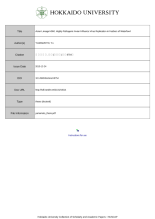Asian lineage H5N1 highly pathogenic avian influenza virus replication in feathers of waterfowl 水禽の羽におけるH5N1亜型高病原性鳥インフルエンザウイルスの増殖に関する研究
この論文にアクセスする
この論文をさがす
著者
書誌事項
- タイトル
-
Asian lineage H5N1 highly pathogenic avian influenza virus replication in feathers of waterfowl
- タイトル別名
-
水禽の羽におけるH5N1亜型高病原性鳥インフルエンザウイルスの増殖に関する研究
- 著者名
-
山本, 佑
- 著者別名
-
ヤマモト, ユウ
- 学位授与大学
-
北海道大学
- 取得学位
-
博士 (獣医学)
- 学位授与番号
-
乙第6754号
- 学位授与年月日
-
2010-12-24
注記・抄録
博士論文
1997 年、アジア系統H5N1 亜型ウイルスによる高病原性鳥インフルエンザ(HPAI)が香港の家禽に発生した。その後、本ウイルスは、アジアからヨーロッパやアフリカへ伝播し、多くの国々に深刻な経済的損失をもたらした。このH5N1 HPAI ウイルスの主要な伝播経路として、野鳥や家禽の移動、汚染鶏肉の流通、生鳥市場等の関連が指摘されている。特に、東南アジアにおける流行には、鶏群におけるHPAI の発生と水生家禽との疫学的関連が報告されている。さらに、斃死した野生水禽からのH5N1 HPAI ウイルス分離が多数報告されている。以上の知見から、著者は、水禽の体内でのウイルス増殖に関する解析が、水禽を介するH5N1 HPAI ウイルスの伝播経路の解明に寄与すると考え研究を行った。本研究において、著者はH5N1 HPAI ウイルスが水禽の羽組織で増殖することを見出し、羽が感染水禽からのウイルス排泄経路に重要であることを提示した。次に、ウイルスに汚染された羽が、健康な鳥や哺乳動物への感染源となりうること示し、公衆衛生の観点から重要であることを指摘した。また、感染水禽の羽が、ウイルス検出のための有用な組織サンプルとして利用できる可能性を示した。最後に、ウイルスに汚染された感染水禽の羽が、環境中において、ウイルス媒介物としての役割を果たす可能性を指摘した。本研究は、H5N1 HPAI ウイルス伝播に水禽の羽組織が関わるという新しい見解を提示した。上記の研究成果が、今後のHPAI の制圧に貢献することを期待する。本論文の各章の概要を以下に記載する。第Ⅰ章では、H5N1 HPAI ウイルス山口株を接種したアイガモにおける病理発生について解析した。ウイルスを接種されたアイガモは斃死や神経症状を示した。脳炎、膵臓壊死、角膜混濁、羽を構成する上皮組織の壊死等の病理所見が認められた。幼アイガモでは高致死率が観察され、水禽の日齢が体内でのウイルス増殖に影響することが示唆された。アイガモの羽でウイルスが増殖することを明らかにし、羽が感染水禽からのウイルス排泄経路となる可能性を提示した。第Ⅱ章では、前章で観察された山口株によるアイガモの羽における増殖に関して、H5N1 HPAI ウイルス清武株やガチョウでの本現象の再現性について検索した。H5N1 HPAI ウイルスを実験感染させたアイガモやガチョウの羽を免疫組織化学、電子顕微鏡検索、およびウイルス分離に供し、山口株および清武株が、アイガモおよびガチョウの羽上皮細胞で増殖したことを確認した。この結果、羽におけるH5N1 HPAI ウイルスの増殖が、感染水禽に共通する現象である可能性が示された。さらに、H5N1 HPAI ウイルスに自然感染した白鳥の羽組織を、病理組織学的、ウイルス学的に検索した。羽軸根からウイルスが分離され、免疫組織化学の結果、羽上皮細胞および羽包上皮細胞にウイルス抗原が検出された。さらに羽のパラフィン包埋標本からH5N1 HPAI ウイルスの遺伝子が検出された。この結果、ウイルスに自然感染した水禽の羽にウイルスが存在しうることが明らかとなった。感染アイガモの綿羽を健康なアイガモに経口投与したウイルス伝播試験の結果、投与アイガモの感染を確認した。この結果、山口株に感染したアイガモの羽が、鳥に対する感染性を有する事が示された。以上の成績に基づき、感染水禽の羽が、動物や人への感染源となりうる可能性について指摘した。第Ⅲ章では、ウイルス検出における、感染アイガモの羽の臨床診断における有用性を評価した。H5N1 HPAI ウイルス清武株および秋田株をアイガモに経鼻接種し、簡易抗原検出キット、ウイルス分離、免疫組織化学、および逆転写PCR を用いて、羽の羽軸根、咽喉頭スワブおよびクロアカスワブからのウイルス検出を経時的に行った。ウイルス分離の結果、スワブと比較して、羽から大量のウイルスが長期間検出された。感染アイガモの羽が、スワブと同様に、ウイルス検出のための有用な試料となりうる可能性を提示した。最後に、感染水禽の羽を介した環境中へのウイルス汚染を評価した。清武株および秋田株を実験感染させたアイガモの羽、飲用水、糞便を採材し、異なる2 つの温度条件下で、試料中のウイルスの感染性の存続期間を解析した。飲用水や糞便と比較して、羽は大量の感染性ウイルスを長期間保持していた。羽組織中からの感染性ウイルスの分離期間は、摂氏4 度で保存された場合160 日間、摂氏20 度の場合15 日間であった。以上の成績から、感染水禽の羽が、野外環境において高力価のH5N1 HPAI ウイルスを含有する感染媒介物として成立する可能性が示唆された。
Asian lineage H5N1 highly pathogenic avian influenza (HPAI) virus has spread from Asia to Europe, the Middle East, and Africa, causing profound economic losses in the poultry industry. Several reports of virus detection in wild and domestic waterfowl indicate that waterfowl can serve as carriers and amplifying hosts of this virus. Therefore, the author hypothesized that the detailed analysis on the pathogenesis and viral replication in waterfowl would provide information to reduce the risk of viral transmission from infected waterfowl. In particular, the author focused on the viral replication in feathers, and discussed the possible role of waterfowl feathers in viral transmission from infected birdsIn chapter Ⅰ, the author examined the pathogenesis in domestic ducks inoculated with Japanese H5N1 HPAI virus. The virus caused mortality, neurologic symptoms, and pathologic changes such as the encephalitis, pancreatic necrosis, corneal opacity and epidermal necrosis of the feathers. High mortality in ducklings indicates that the age of birds is a factor influencing on the viral replication. The feather lesions caused by virus replication raise the potential of feathers as new route of virus shedding from waterfowl infected with H5N1 HPAI virus. In chapter Ⅱ, the experimental infection was performed to examine whether the feather lesion observed in the previous chapter is common to other H5N1 HPAI virus strains or other waterfowl species. Two different clades of the virus replicated in the feather epidermis of domestic ducks and geese in experimental infection. Electron microscopic examination provided the direct evidence of viral replication in feather epidermal cells. Viral replication in the feather tissue was also found in whooper swans naturally infected with the virus. In addition, the viral transmission was confirmed in domestic ducks by oral inoculation of down feathers plucked from a duck infected with the virus. In chapter Ⅲ, it was reported that feathers of infected domestic ducks can be useful samples for virus detection as well as their swabs. In the experimental infection using 2 H5N1 HPAI viruses and domestic ducks, larger amounts of viruses were isolated for longer period from feathers than from the swabs, indicating that feathers are considered to be useful clinical samples for surveillance or diagnostic examination of H5N1 HPAI virus in domestic ducks. The author also investigated the viral persistence in feathers detached from bodies of domestic ducks infected with H5N1 HPAI viruses to evaluate the possible environmental contamination by infective feathers. Feathers plucked from experimentally infected domestic ducks were examined by virus isolation. Infectious viruses persisted for the longest period in feather calami compared with drinking water and feces. Viral infectivity persisted in the feathers for 160 days at 4oC and for 15 days at 20oC. These results indicate that feathers detached from domestic ducks infected with H5N1 HPAI virus can function as fomites containing high viral loads in the environment.In conclusion, the author presented a new viewpoint on an epidemiological role of waterfowl feathers in Asian lineage H5N1 HPAI virus transmission.


